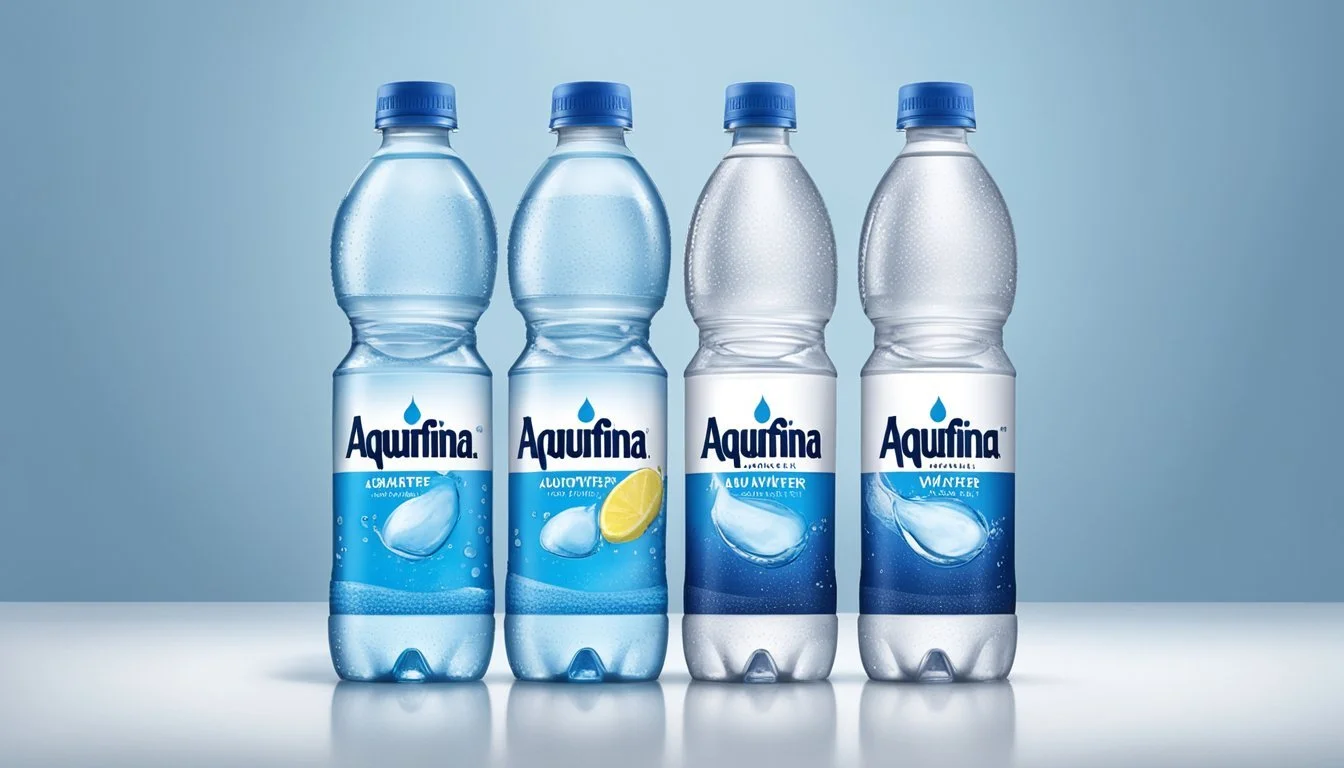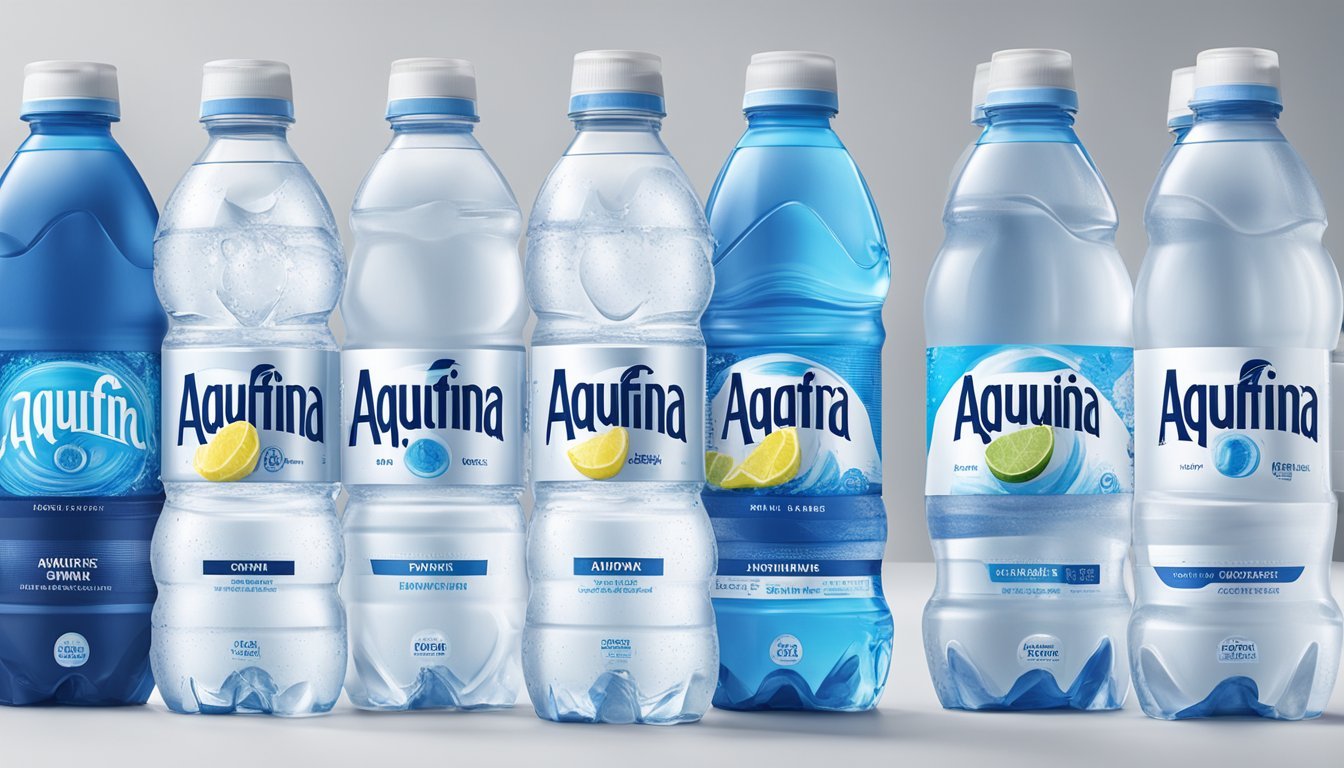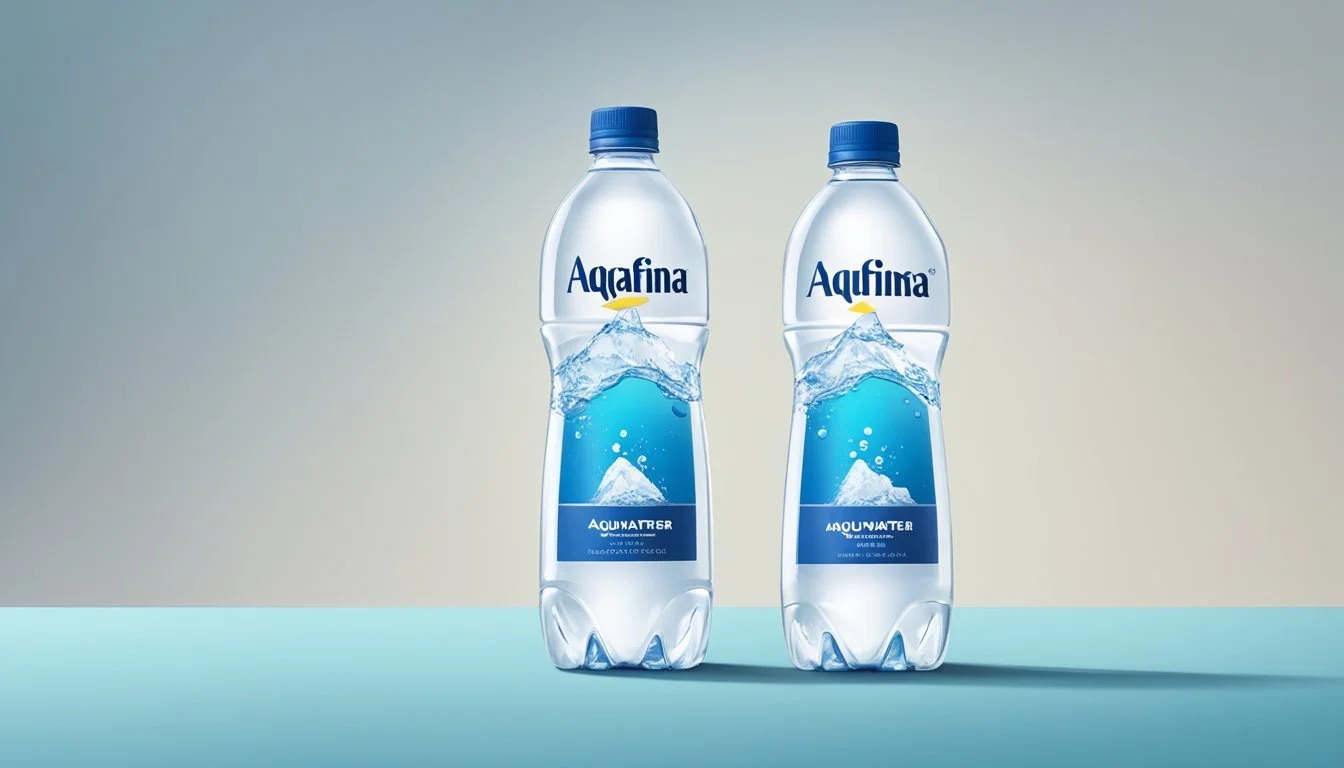Aquafina vs. Smartwater
An Unbiased Comparison of Bottled Water Brands
The bottled water industry has seen a significant rise in consumer demand over the years, with a marked proliferation of brands offering hydration with an avowed purity and mineral composition. Among these, Aquafina and Smartwater have emerged as major players, commanding substantial market share and consumer preference. They are often pitted against one another as consumers debate which brand provides a better taste, quality, and overall value. The competition between the two is reflective of broader questions regarding sustainability, health impacts, and the environmental footprint of bottled water.
Aquafina, produced by PepsiCo, purifies water using a rigorous seven-step process that includes reverse osmosis and other filtration methods. This results in a product that is consistently pure and devoid of minerals and ions. Smartwater, on the other hand, made by The Coca-Cola Company, distinguishes itself with its vapor distillation process and the addition of electrolytes for taste enhancement. It is marketed as having a crisp, clean taste as a result of its production method, paralleling the natural water cycle.
When evaluating Aquafina and Smartwater, consumers consider not only the taste but the source, treatment process, and supposed health benefits that come with the electrolytes in Smartwater. The debate also encompasses the environmental policies of the parent companies, packaging materials, and their commitments to sustainability. In determining which bottled water is better, one must weigh these multifaceted aspects against personal preferences and values.
Origin and Source of the Waters
This section will examine the specific origins and filtration processes of Aquafina and Smartwater, and how they compare to other forms of natural water sources.
Aquafina: Purified Tap Water
Aquafina is a brand of bottled water that originates from public municipal water supplies. The water undergoes a rigorous purification process involving reverse osmosis, ozonation, and other filtering methods. Despite its source being tap water, the purification steps are designed to remove most impurities, resulting in a clean and taste-neutral product.
Smartwater: Vapor-Distilled Source
Smartwater, another popular bottled water brand, derives its product from municipal water sources as well. However, it uses a different method known as vapor distillation, a process akin to the hydrologic cycle. This method coupled with the addition of electrolytes is intended to provide a distinctive, crisp taste.
Comparing Natural Sources
When comparing bottled water like Aquafina and Smartwater to brands sourced from natural springs, various factors come into play. Brands such as Poland Spring and Mountain Valley Spring Water source their water directly from protected mountain springs. On the other hand, Fiji Water boasts artesian water filtered through volcanic rock, and Evian is known for its origin in the French Alps, boasting naturally filtered water through permeable layers. This natural filtration process is said to add unique mineral compositions and flavors associated with the source's terroir. Voss, originating from Norway, and Ice Mountain, sourced from springs across the midwestern U.S., similarly emphasize their pristine natural sources.
Natural spring waters generally come from underground springs, where water is naturally filtered and may collect minerals and elements from the surrounding rocks. Mountain Valley, originating from a spring in Arkansas, is known for its unique mineral content and taste profile. Zephyrhills is sourced from Florida's subterranean springs, offering a fresh taste from the natural aquifer. In stark contrast, Dasani, like Aquafina, starts with local municipal water supplies before undergoing purification.
Each brand's source—whether it's a mountain spring, underground aquifer, or municipal water supply—plays a critical role in defining the final quality and taste of the bottled water. While Aquafina and Smartwater are created from municipal sources with advanced purification technology, many consumers hold a preference for the naturally occurring minerals and elements found in waters like Fiji, derived from natural aquifers beneath Viti Levu, or those filtered through tropical rainfall and mountainous terrain.
Composition and Health Benefits
Choosing between Aquafina and Smartwater requires understanding the composition and health benefits of each. This section focuses on what sets these bottled waters apart regarding electrolyte enhancement, mineral content, and their overall impact on hydration and health.
Electrolyte Enhancement
Aquafina is essentially purified tap water that goes through a rigorous purification process known as HydRO-7. This process removes substances like chlorides, salts, and other volatile compounds, ensuring it is free of electrolytes and minerals. In contrast, Smartwater, manufactured by Glacéau, is vapor-distilled with added electrolytes such as potassium bicarbonate, calcium chloride, and magnesium chloride for taste.
Mineral Content of Bottled Waters
While neither Aquafina nor Smartwater are marketed for their mineral content, Smartwater's addition of electrolytes can slightly affect its mineral profile. Aquafina, being purified, minimizes exposure to potential contaminants such as heavy metals. Smartwater, following the vapor distillation process, aims to replicate the process of the hydrologic cycle, and the added electrolytes are meant to mimic the trace amount of minerals that might be found in natural spring water.
Hydration and Health Impact
Both Aquafina and Smartwater provide adequate hydration, a key to maintaining health by supporting kidney function, regulating body temperature, and improving skin quality. Neither brand has a high enough concentration of minerals or electrolytes to claim significant health benefits over the other. However, it is important to note that Smartwater has a slightly more alkaline pH level, which some consumers prefer, whereas Aquafina is more neutral. While no conclusive evidence suggests alkaline water offers more health benefits, some individuals favor it for its taste.
Both brands are safe options for staying hydrated, and personal preference for taste or mild differences in electrolyte content may guide individual choices.
Taste Profiles and Preferences
In the realm of bottled water, taste profiles and preferences can vary widely, influenced by factors such as mineral content and purification processes. Consumers and water sommeliers alike scrutinize these attributes to discern the nuances between brands like Aquafina and Smartwater.
Taste Enhancement Methods
Aquafina utilizes a complex purification system that includes reverse osmosis and ozonation, which strips the water of minerals and impurities. This process results in a distinctly pure and neutral taste profile, oftentimes perceived as plain but refreshing. In contrast, Smartwater is vapor-distilled with added electrolytes, aiming to improve taste with a slightly ionized flavor. The minerals added for taste mimic the flavor profile of some naturally occurring mineral waters.
Sommelier Insights on Water Taste
Water sommeliers examine water much like wine experts, focusing on terroir—or the origin and environment where the water is sourced. They note that the taste of water reflects its journey through the ecosystem and mineral deposits it encounters. Although Aquafina’s origin water source before purification is variable, it lacks distinctiveness post-treatment. Smartwater, while also starting with municipal sources pre-distillation, is lauded for its crisp and subtly enhanced mineral taste post-addition of electrolytes, which is preferred by some sommeliers who value a touch of character in water.
Consumer Taste Perceptions
Consumer perceptions of bottled water taste often align with individual preferences for either a pure or mineral-enhanced experience. Surveys and blind taste tests have revealed a split in preference:
Pure Taste: Some consumers prefer the clean and straightforward taste of Aquafina, often associating its lack of flavor with purity and cleanliness.
Enhanced Taste: Others lean toward the unique and slightly mineralized taste of Smartwater, often claiming that the added electrolytes provide a more satisfying and nuanced drinking experience.
Safety and Quality Standards
When evaluating bottled water brands like Aquafina and Smartwater, it's crucial to consider the nuances of their safety and quality standards. This includes understanding the filtration and purification processes, compliance with regulatory standards, and the methods utilized for contaminant and quality testing.
Filtration and Purification Processes
Aquafina utilizes a hydro-7 purification system, which is a seven-step process that includes filtration with activated carbon, reverse osmosis, and ultraviolet light exposure. This is designed to remove substances like chloride and other contaminants to produce purified water.
Smartwater, on the other hand, starts with municipal water which then undergoes vapor-distillation, a process inspired by the natural water cycle, followed by the addition of electrolytes such as potassium chloride for taste, resulting in what they market as vapor-distilled water.
Regulatory Standards and Compliance
Both Aquafina (owned by PepsiCo) and Smartwater (owned by Coca-Cola) must comply with regulatory standards set by entities such as the Environmental Protection Agency (EPA) in the United States. This ensures that their bottled waters meet specific safety guidelines for consumption.
Bottled water brands, including those like Nestle's Pure Life and PepsiCo's Lifewtr, are subject to EPA regulation, which involves stringent guidelines for contaminant levels, reporting, and quality assurance.
Contaminant and Quality Testing
Contaminant testing is a critical aspect of ensuring bottled water safety. Both brands conduct regular tests for a variety of potential contaminants, including PFAS chemicals known to be present in some plastic bottled waters.
Other materials, such as those used in Brita or carbon filtered systems, are known for their ability to filter out various contaminants. The quality of water is often tested through these methods to detect the presence of any harmful substances and ensure each bottle meets or exceeds the required safety standards before reaching the consumer.
Branding and Market Positioning
In the bottled water industry, brands like Aquafina and Smartwater have carved distinct images for themselves. They have positioned their products at different levels of the market, targeting their strategies towards diverse consumer segments.
Affordable Versus Upscale Brands
Aquafina, owned by PepsiCo, has positioned itself as an affordable and accessible brand. It is commonly found in supermarkets and convenience stores, making it a well-recognized choice for everyday hydration. In contrast, Glaceau Smartwater, part of the Coca-Cola portfolio, targets the upscale market segment. Smartwater’s branding centers on its premium quality, promoting itself as a vapor-distilled product with added electrolytes for taste.
Marketing Strategies of Leading Brands
PepsiCo markets Aquafina using traditional advertising channels and emphasizes its purity. The company has also responded to environmental concerns with initiatives to reduce plastic usage. In comparison, Smartwater focuses on sophisticated marketing campaigns showcasing celebrity endorsements and sleek packaging, which appeal to a consumer base looking for a luxurious hydration experience.
Consumer Brand Perceptions
Consumers tend to perceive Aquafina as a reliable and classic option in the bottled water category. Smartwater, with its modern branding efforts, garners a perception of being an innovative and chic alternative. Surveys and market analyses reveal that brand loyalty is significant in this sector, with Aquafina and Smartwater both enjoying a dedicated customer base due to their distinct market positioning.
Environmental and Sustainability Concerns
When comparing bottled water brands like Aquafina and Smartwater, it is essential to consider their environmental footprints. Factors such as plastic usage and sourcing practices play significant roles in determining the sustainability of these products.
Plastic Use and Waste Management
Aquafina and Smartwater are packaged in plastic bottles, which raises concerns over plastic waste and recycling efficacy. Plastic bottles can take hundreds of years to decompose, adding to environmental pollution if not properly managed. Both brands have a responsibility to ensure that their plastic bottles are recyclable, and they must actively encourage consumers to recycle.
Aquafina: Uses a lightweight plastic bottle which requires less material.
Smartwater: Encourages recycling; bottles are often 100% recyclable.
Sourcing Impact and Conservation
The process of sourcing water for Aquafina and Smartwater involves the extraction of water from the environment. This can have various impacts on local ecosystems and water conservation efforts.
Aquafina: Often sourced from public water sources before undergoing purification.
Smartwater: Vapor-distilled, originating from various sources before purification.
While both brands utilize purification processes, the extraction of water should consider long-term sustainability and the well-being of local environments. Consumers are increasingly encouraged to use reusable water bottles to minimize impact, as even purified, plastic-bottled waters contribute to environmental concerns.
Alternatives to Bottled Water
While bottled water like Aquafina and Smartwater is convenient, consumers have several alternatives that can be more sustainable and economical.
Tap Water Safety and Considerations
Tap water is the most accessible alternative to bottled water, generally costing a fraction of the price. Municipal water supplies are strictly regulated for safety. However, it's important for consumers to be aware of potential contaminants, such as lead, which can leach from old pipes into the water supply. It's advisable for individuals to check their local water quality reports, which are often available on their city's website, to ensure their tap water meets safety standards.
Filtered Water Options
For those concerned with the quality of their tap water or who simply prefer the taste of filtered water, there are various options available. Brita filters are a popular choice, capable of reducing common contaminants and improving taste. These can be used with a reusable water bottle, offering both an eco-friendly and cost-effective solution. When using a filter, following the manufacturer's guidelines for filter change is crucial to maintain water quality. Another available option is installing a filtration system directly onto the tap or the home's water supply to provide consistently clean water.
Expert Opinions and Advice
In the debate between Aquafina and Smartwater, experts weigh in on both health implications and environmental impact, which are crucial for an informed choice.
Health Expert Recommendations
Health experts emphasize the importance of hydration and the purity of drinking water. Aquafina, purified through a rigorous 7-step HydRO-7 filtration process, ensures the removal of substances more than most other bottled waters. On the other side, Smartwater is not just distilled but also contains added electrolytes for taste. While some dietitians suggest that the added electrolytes may offer marginal post-workout benefits, they are generally not necessary for the average person's daily hydration needs.
Aquafina: Purified, suitable for everyday hydration
Smartwater: Distilled, with added electrolytes, which may be beneficial post-exercise
Environmental Expert Insights
Environmental experts tend to scrutinize bottled water brands for their ecological footprint. Both Aquafina and Smartwater are produced by companies that have faced criticism over environmental concerns. The experts advise consumers to look into the source and production practices of these brands. Smartwater uses vapor distillation, a process that is intensive in energy consumption. In contrast, Aquafina, produced by PepsiCo, has made commitments toward sustainable practices, including reducing plastic use and improving recycling efforts. However, neither brand is considered ideal from an environmental standpoint when compared to using a reusable water bottle and filter system.
Aquafina: Initiatives to reduce plastic use and improve recycling
Smartwater: Vapor distillation process with higher energy consumption
Consumer Choices and Behaviors
Consumers often make choices based on a combination of factors such as price, convenience, and brand reputation. They tend to gravitate towards products that are accessible and offer perceived value, whether that is an affordable price point or an upscale brand image.
Buying Decisions and Patterns
When choosing between bottled water brands like Aquafina and Smartwater, customers consider several attributes. These factors often include:
Price: Consumers consistently evaluate the affordability of bottled water, and Aquafina is often perceived as a more cost-effective option compared to Smartwater.
Brand Perception: Smartwater has positioned itself as an upscale brand, which can influence purchasing decisions for those who prefer premium products.
Taste and Quality: Perceived taste and water quality can sway a buyer's preference, although both brands are often praised for their purity and clean taste.
Patterns suggest that repeat purchases are influenced by a customer’s initial satisfaction with the product. Factors such as flavor, packaging, and marketing messages play a critical role in shaping consumer loyalty.
Preference for Convenience
The availability of a product strongly impacts consumer behavior, with convenience sometimes outweighing cost and brand loyalty. Considerations include:
Retail Accessibility: Aquafina, being widely distributed, is readily available at a variety of retailers, making it a convenient choice.
Packaging Options: Both brands offer different packaging sizes, but consumers typically prefer those that are easy to carry and store.
Speed of Purchase: The consumer’s desire for a quick transaction may lead them to grab a familiar brand like Aquafina off the shelf.
The emphasis on convenience is a defining factor in the fast-paced bottled water market. Accessibility at points of sale can indeed make or break a purchasing decision.
Innovations in Bottled Water
The bottled water industry has seen significant advances with the introduction of new brands and technologies, alongside evolving consumer trends.
Emerging Brands and Technologies
Emerging Brands: New players like Essentia are disrupting the market with enhanced products. Essentia offers water with increased electrolytes, marketing it as supercharged to support hydration.
Technological Innovations:
Electrolyte Infusion: Increasing electrolytes in water to improve taste and hydration.
Filtration Systems: Advanced methods to enhance purity and taste.
Future Trends in Water Consumption
Sustainability: As environmental awareness increases, brands like Deer Park are focusing on eco-friendly packaging.
Health Conscious Trends:
Consumers are leaning towards products with health benefits, like electrolyte-infused water.
There's a growing interest in carbonated water as an alternative to sugary sodas.
Smart Packaging: The future may see smart water bottles that track consumption and hydration levels.
Conclusion
The comparison between Aquafina and Smartwater has highlighted each brand's distinct features and water quality attributes.
Summary of Comparative Insights
Aquafina, produced by PepsiCo, reportedly has a higher acidity level. The pH level of this bottled water is more acidic than neutral, marking a distinction from Smartwater. Although not the worst bottled water in terms of quality, consumers often seek water closer to a neutral pH.
Smartwater, a product of Coca-Cola, stands out for its added electrolytes and vapor-distilled process. While studies indicate that it also leans towards a more acidic pH level, Smartwater's marketing emphasizes purity and electrolyte enhancement for taste.
Final Recommendations
For those prioritizing electrolyte content for taste and hydration, Smartwater may be the preferable choice. Conversely, when considering cost-effectiveness, Aquafina may appeal to those who are less concerned with pH levels and the added benefits of electrolytes. It's worth noting that neither brand is classified as alkaline water, a type some consumers prefer for its purported health benefits. When selecting the best bottled water, it's recommended to weigh these individual preferences against the available offerings.









